The December current population survey unemployment report is just plain weird. First, the unemployment rate dropped another 0.3 percentage points to 6.7%, the lowest unemployment rate since October 2008. The unemployment rate dropped because over half a million people dropped out of the labor force. The unemployment rate's dramatic decline for 2013 is due primarily to people no longer being counted. The ranks of the employed has only increased 1.4 million over the past year while the population no longer part of the work force has swelled by almost three million.
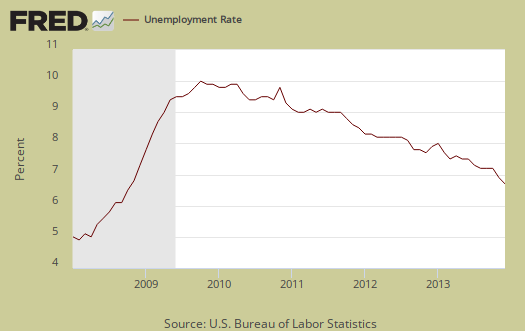
This article overviews and graphs the statistics from the Employment report Household Survey and frankly this report is simply not good news. The ranks of the employed did increase by 143,000, so this does imply some people obtained work, yet this is not nearly enough to justify the plunging unemployment rate above. The employed now tally 144,586,000.

Those unemployed stands at 10,351,000, a -490,000 drop from last month and a main reason why the unemployment rate declined by -0.3 percentage points in a month. Below is the change in unemployed and as we can see, this number normally swings wildly on a month to month basis generally. A sudden drop in the ranks of the official unemployed does not necessarily mean those people found new jobs.
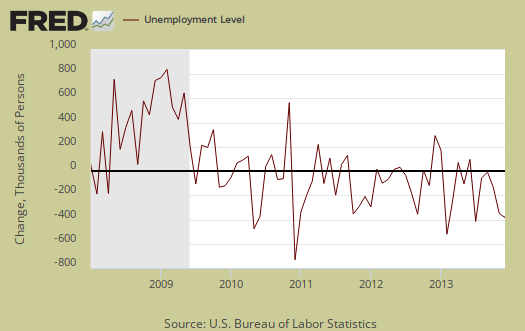
Those not in the labor force shot up by 525,000 persons. The below graph is the monthly change of the not in the labor force ranks. Notice the increasing swells and wild monthly swings. These are not all baby boomers and people entering into retirement as we showed in this analysis of labor participation by age.

The most frightening statistic of the household survey is the labor participation rate. The labor participation rate decreased again by -0.2 percentage points to 62.8%. This is a record low, seen just two months ago and previous to that, not seen since March 1978. For those claiming the low labor participation rate is just people retired, we proved that false by analyzing labor participation rates by age and bear in mind one must take BLS data at annual intervals, else the January only population adjustments with throw off any analysis. Bottom line, the dramatic increase of those not in the labor force is not due to baby boomer's retiring. People are not finding jobs and dropping off of the unemployed radar map.
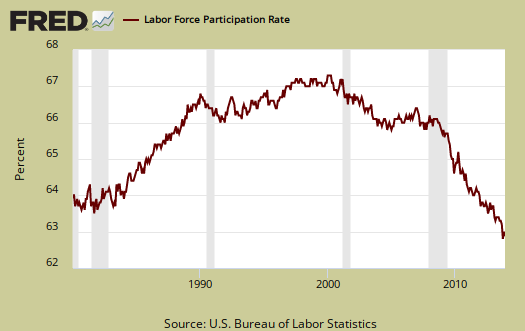
The civilian labor force, which consists of the employed and the officially unemployed, dropped by -347 thousand in a month. The civilian labor force has shrank by -548,000 over the past year.
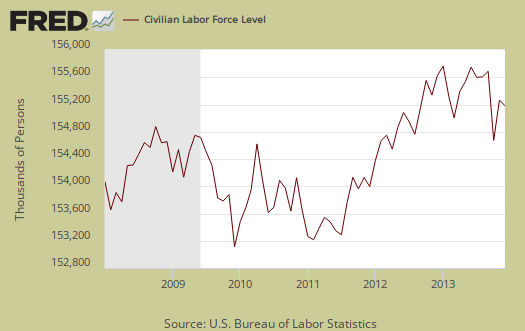
In spite of wild statistical swings, those not in the labor force grows faster than the population which has the potential to work. Below is a graph of those not in the labor force, (maroon, scale on the left), against the noninstitutional civilian population (blue, scale on the right). Notice how those not in the labor force crosses the noninstitutional civilian population in growth and the accelerated growth started happening right in 2008. There were not that many babies born in 1943 to explain the steep 2008 increase.

Below is a graph of the civilian labor force, or the official employed plus unemployed, in maroon, scale on left, against those not in the labor force, in blue, scale on right. Notice how those not in the labor force as a trend exceeded those considered employed and unemployed starting around mid 2009. What we have seen is a never ending growing segment of the population that is considered neither employed or unemployed, i.e. not in the labor force, increasing, above the trend line of those who would be naturally dropping out, such as the retired and those in school. Not in the labor force figures do include retirees.
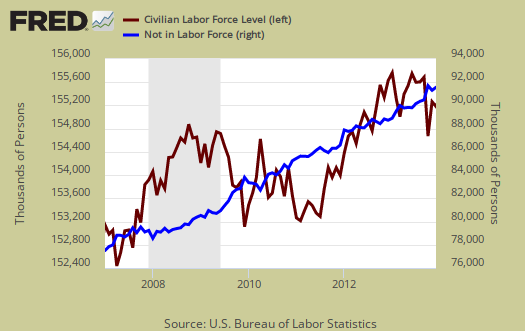
Those considered employed as a ratio to the total Civilian noninstitutional population had no change and stand at 58.6%. Generally speaking the employment to population ratio has been hovering around 1983 record lows for years now and in 1983 there were more families with a stay at home mom, with wages high enough for only one adult to work and support a family and a very steep recession. The low ratio implies there are many people who could be part of the labor force are not anymore, as shown in the graph below. For the interested, there is a relationship between the employment-population ratio and the labor participation rate (LPR): employment-population ratio = LPR * (1 - unemployment rate). The drop in the unemployment rate is the reason the employment to population ratio did not change.
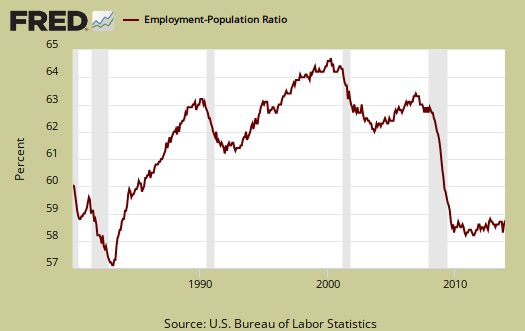
There are millions of people who need full-time jobs with benefits who can't get decent career oriented positions. Those forced into part time work is now 7,771,000, an increase of 48,000 from last month. Those stuck in part-time has declined only by -158 thousand from a year ago. For those who believe people are choosing part-time work, this very elevated figures prove that claim wrong. The below graph shows levels of people who could only get part time hours have remained elevated since the recession and these are all people who want full-time, they just cannot get it, it is not by choice.

There are two categories of those working part-time hours. Those who could only get part-time jobs and those working who got their hours cut due to businesses not having enough work for them. The number of people who could only get part-time work increased by 93 thousand to 2,592,000. The number of people who could only find part-time work is shown in the below graph and from a year ago has not budged.
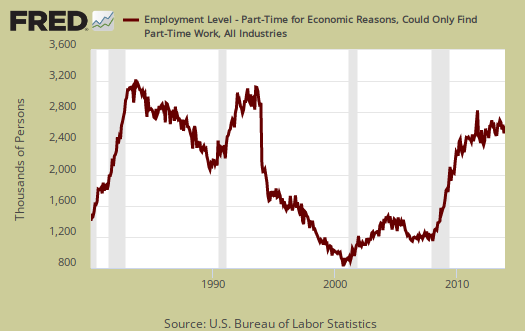
People can also be stuck with part-time hours due to slack working conditions. This figure has remained just obscenely high for years now and this month stand at 4,884,000 This is an incredible number of workers who are getting their hours slashed due to weak economic demand. Below is a graph of forced into part-time work because they got their hours cut, as a percentage of the total employed. Part-time work due to cut hours is known as slack work conditions. Slack working conditions causing part-time hours remaining high or increasing implies economic conditions have not improved enough, that there still is just not enough demand in the economy for businesses to run full steam. Below is a graph of forced part-timers due to slack work conditions as a percentage of the civilian labor force. This is a recession economic indicator, notice the line slope matches strongly the gray recession bars of the graph.
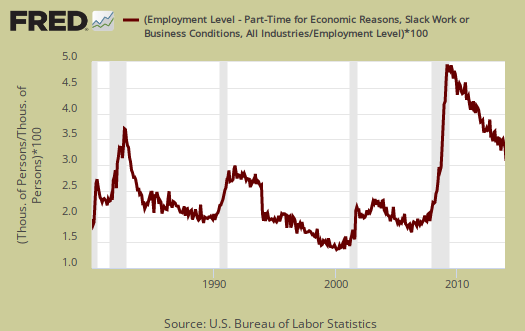
U-6 is a broader measure of unemployment and includes the official unemployed, people working part-time hours because that's all they can get and a subgroup not counted in the labor force but are available for work and looked in the last 12 months . The U-6 alternative unemployment rate still leaves out some people wanting a job who are not considered part of the labor force. U-6 was unchanged from last month and stands at 13.1% in spite of the official unemployment rate drop. .
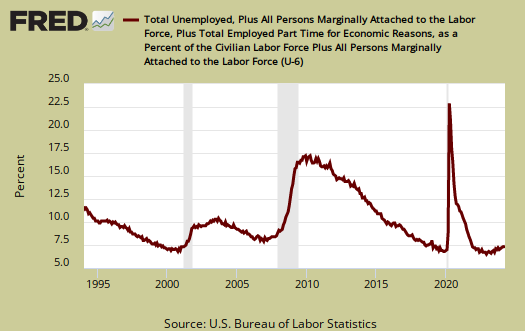
The long term unemployed, or those unemployed for 27 weeks and over, declined by -166,00 and stands at 3,878,000 people. The long term unemployed are the crisis of our time and we know these people did not get jobs since the ranks of the employed gained less than the decline in the long term unemployed. From a year ago the long term unemployed ranks have decreased by -894,000, but this does not mean at all these folk found work.

The marginally attached are people not in the labor force because they have not looked for a job in the last month, but have looked for a job in the last year. This number has ballooned since 2007 and not returned to pre-recession levels. The graph below is the number of people considered marginally attached to the labor force, currently at 2,427 million. The marginally attached should only be viewed as a long term trend for the figures are also not seasonally adjusted.
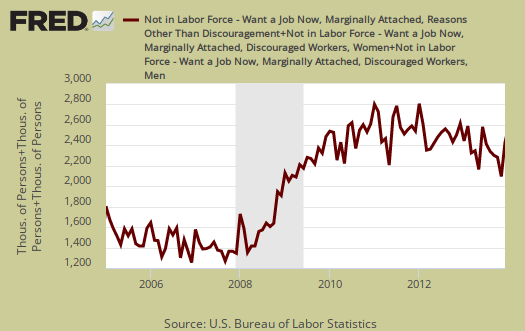
Discouraged workers are people, not counted as part of the civilian labor force, who not only want a job, but also looked for one in the last year. These people aren't job hunting now because they believe there are no jobs out there. Below is the graph of discouraged workers, currently at 917,000 people and are a subset of the marginally attached. Discouraged workers is kind of a barometer for how the job market is perceived. From a year ago workers discouraged has declined by only 151,000. In other words this figure really isn't dropping much.
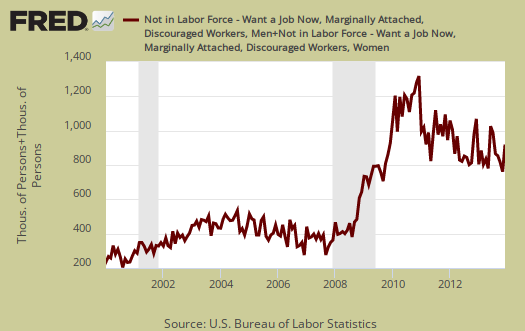
Our favorite statistic from the CPS survey is how many people who are considered not in the labor force, report they want a job now. It is a direct survey question from the CPS. The survey asks people who are not being counted in the unemployment statistics and official unemployment rate if they want a job. The number who answer yes currently stands at 6,111,000. This is is a huge figure! Those who are not counted yet report they want a job includes the discouraged workers and marginally attached and is seasonally adjusted.

The average length of unemployment is 37.1 weeks. Think about this fact when contemplating how the GOP wants to deny unemployment insurance benefits past 26 weeks. The average duration is so high due to the long-term unemployed who represent 37.7% of the unemployed. Many long term unemployed face age discrimination as well as discrimination for the fact they need a job, one of the worst injustices in America.

The median time one is unemployed, which means 50% of people have gotten a job in this amount of time, and is 17.1 weeks. This is over four months to be without a paycheck as the median, that's quite high and bear in mind even after that length of time 50% of the people still can't find work.
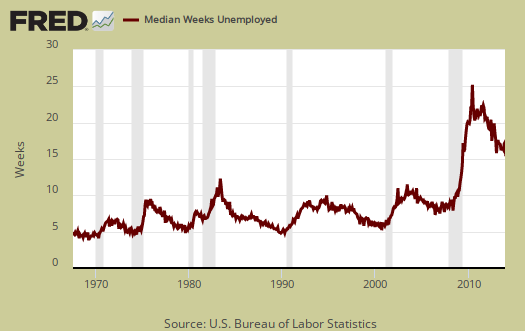
Those unemployed less than five weeks saw a huge decline, -184 thousand from last month. Those unemployed between five weeks and 14 weeks decreased by -79 thousand and people who had been unemployed for 14 weeks to 26 weeks declined by --91,000. As previously noted, the long term unemployed decreased by -166 thousand. . A drop in the unemployed does not necessarily mean they found a job.
The household survey gives the reason for new unemployment status. Job losers and those who completed temporary jobs came back barreling down by -365,000 to 5,366,000. What has happened is layoffs have stopped and the mass firing of works also seems to have ceased. Temporary layoffs declined by -131,000 while those who lost their job dropped by -209 thousand. This is consistent generally speaking for some time. While hires and job creation is lax, layoffs and fires have dramatically declined. Below is a graph of job losers by levels. While the figure has dropped dramatically it is still higher than any other recession. Job losers are still 51.3% of the total unemployed. In other words people are still losing their jobs as a pattern in comparison to before 2008.

People join the ranks of the unemployed because they were laid-off, fired, they quit, the job was temporary and thus ended, they entered the labor force for the first time and re-entrants. Re-entrants are people with work experience, yet have been considered not in the labor force for some time. Recall to be considered unemployed one has to be actively searching for a job or expecting to be recalled and on temporary layoff. Re-entrants decreased by -29 thousand people this month. Below are re-entrants as a percentage of the total unemployed. As you can see, as jobs and opportunities appear, people re-enter the labor force looking to snap one of those jobs. Considering the massive damage still to the U.S. job market, the below tells us things really have not improved enough. If there were really a lot of job opportunities out there, the slope of this graph would spike up and should spike up to the extremes since there are so many who have stopped looking, are not counted as unemployed currently, who could re-enter the labor market.
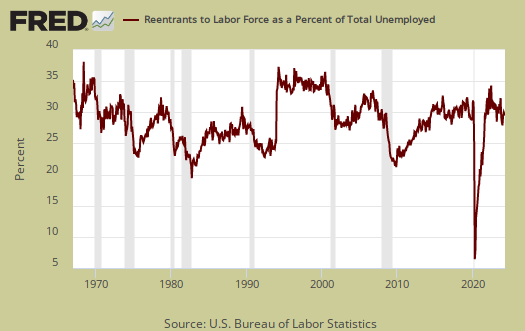
If one looks at the levels of re-entrants, or people considered not in the labor force who started actively looking for a job again, the levels are at all time highs in spite of the annual decline. This is yet another sign on how people are not finding work, giving up, then dropping out of the labor force and then trying again to get a job. If the job market was good for a long period we'd see this statistic finally drop as new entrants would have found work instead of being once again officially counted as unemployed.
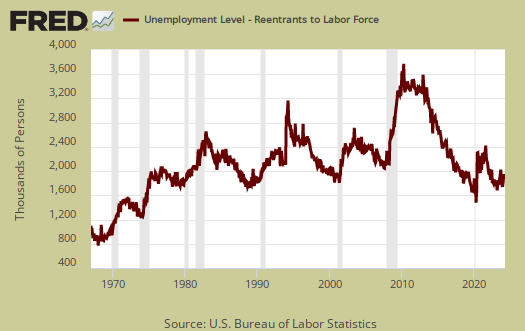
To sum up this month's household survey, we have another month with a massive increase in those not in the labor force. Layoffs clearly have dissipated, so less people are losing their jobs versus real job creation is also happening. If anything this overview explains why one should not put stock in the official unemployment rate for beneath the waves lurks some very scary statistics still.
Here is our past overviews CPS unemployment statistics.

I'd like to Speak my mind, 2 cents at a time ;)
Exactly!!! The labor force is shrinking for lack of jobs --- and not (as some people claim) because "baby boomers are shuffling into retirement."
http://bud-meyers.blogspot.com/2014/01/the-labor-force-is-shrinking-for-...
Fed study I think is flawed
and I reference that in this post. His time window is 1.5 years, thus he has population controls bias in his figures. The BLS only puts population controls in the December to January change and it is not regression adjusted to average across 12 months.
See this post for more details.